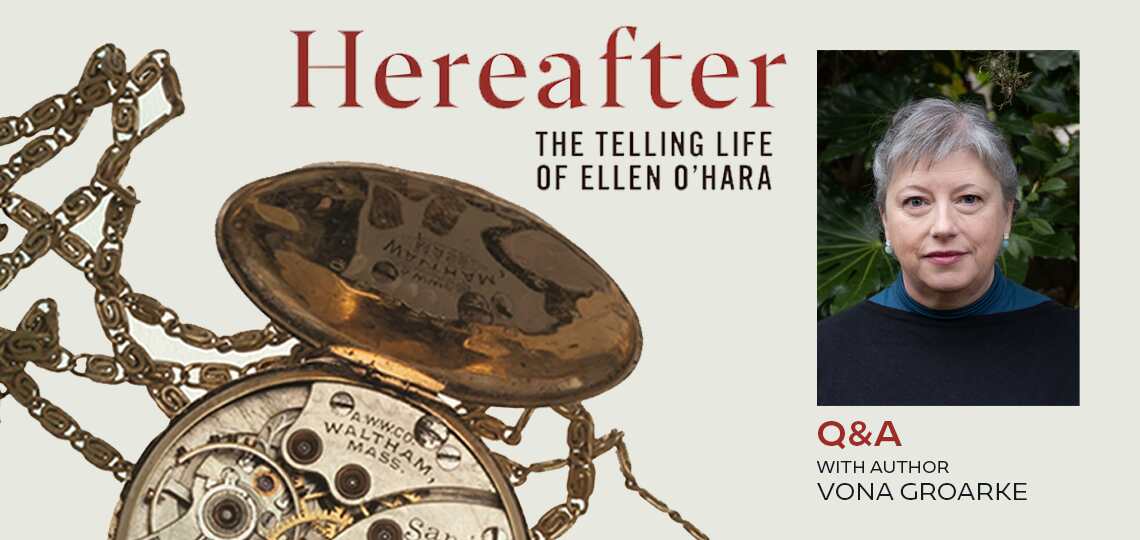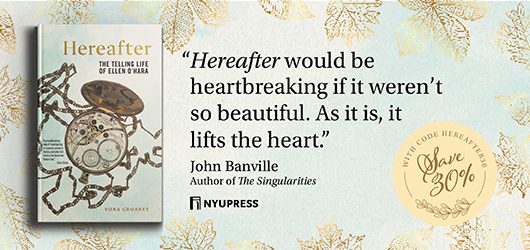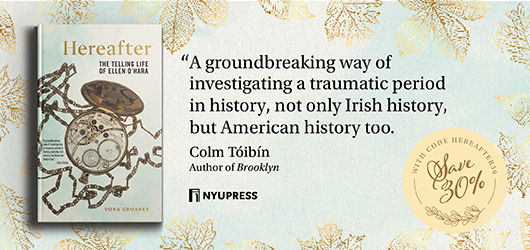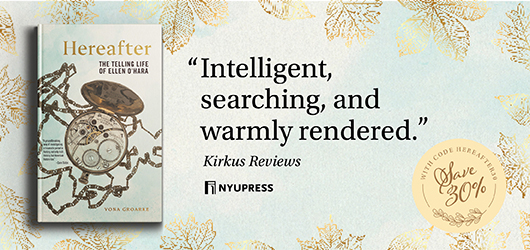A genre-bending book from one of the best poets writing in Ireland today

Executive Editor Matt Sutherland Interviews Vona Groarke, Author of Hereafter
There are more than a few reasons why the Irish have a hard-luck reputation. They couldn’t catch a break from the marauding Vikings, for example, and the country’s testy relationship with England for eight or so centuries featured more disdain and mistreatment from the colonizer than rolling good times.
But the mother of Irish maladies would surely be the Great Potato Famine of 1845, a devastating handful of years when Ireland lost a quarter of its population, half through starvation and half through emigration. Those emigrants were exceptionally hardworking to the benefit of the United States and other countries, in large part because they were committed to sending money back to family in Ireland. Estimates have it that more than $250 million was transferred from the US to Ireland between 1848 and 1900.
Today, we’re pleased to spend a few minutes with Vona Groarke, author of a captivating new book about her great-grandmother Ellen O’Hara, who emigrated from impoverished County Sligo in Ireland’s south to New York in 1882. Foreword‘s Executive Editor Matt Sutherland reached out to her with a few questions after becoming enchanted with Vona’s innovative approach to telling Ellen’s story.
Enjoy!
This is not your ordinary Irish immigrant story. You attempted—succeeded, in my mind—to do something very different with Hereafter. Tell us how you came to write it, and the decisions you made in its execution?
One lunchtime in late 2018 I idly entered the name Ellen O’Hara into the various archival databases of the New York Public Library, where I was a Fellow of the Cullman Center. Ellen, my mother’s grandmother, was a set of stories I’d heard decades before—as much as anything, I suppose I wanted to see if any of them might hold up to evidence and prove true. After discovering that Ellen left a very light trace on the official record, my job was to think about how to tell a story with so many holes in it. I knew it wouldn’t be a novel (I’m not a novelist), but I also knew it wouldn’t be a book of poems. It would need to have a narrative arc and a couple of strong characters to infill the story. And it wasn’t going to be the kind of book where I’d give myself imaginative free rein. To honor Ellen (and all the Ellens), the book would have to rest on historical truth. I also wanted the book to be interesting, formally, if only so it would keep me involved and engaged as I was writing it.
So those were the elements: poetry, lyric prose, a strand of fiction, history, and images. Weaving them together was the work of many edits, trying to achieve an interesting balance between them, and to propel the story on. The other all-important ingredient was the design, which was out of my hands. I’m very fortunate that Martin Coleman at New York University Press, the publishers of Hereafter, was so receptive to what the book was doing, and so carefully responded to its different strands, finding interesting ways to visually represent them so they have some independence, but also cohere into a whole.
I don’t really know of another book with quite the formal experiment of Hereafter. “Formal experiment” can be dangerous words—there’s something almost scientifically off-putting about them, but I hope I’ve written a book that will be enjoyable to several different kinds of readers: those who like a good story and who want plot, and lots of it; those who are interested in the ways in which writing thinks about itself; and those who recognise something of the story in their own family lore—who will read onto Ellen their own female line, whose stories might chime with hers.
The great potato famine hit Ireland in 1845 and lasted for years. Can you give us a sense of how devastating it was to the Irish people, especially in the regions near Ellen’s family home, and how the subsequent migrations took place?
The Great Famine removed twenty-five percent of the Irish population: one million died, one million emigrated. While there wasn’t a corner of Ireland entirely unaffected, the poorer areas certainly suffered most, having almost total reliance on the potato crop as their main food source. Other famines occurred sporadically throughout the rest of the nineteenth century, but none so drastic as the Great Famine.
Ellen’s family came from a mountainous area in south County Sligo—poor land, backing onto Lough Talt, so probably quite waterlogged, too. With a good harvest, they would have fed themselves with what potatoes and vegetables they grew, and financed the rent on their smallholding out of the proceeds of their additional farming; in their case, probably animal husbandry. In the years of potato blight, the rent still had to be paid in full out of often severely curtailed income. Obviously something had to give. With so few resources to hand, one they did have was large families: after the Great Famine, it was not unusual for a good number of children to leave Ireland and, by sending back money from their wages abroad, to guarantee the rent and, by extension, the family homestead. That was a brutal economy, really, but was a kind of efficient answer too, whatever the emotional cost of such an enterprise.
One of the surprising facts I learned in my research was that the construction of many of the railway lines in the West of Ireland coincided with the periods of greatest emigration: it’s obvious, really, when you think about it, but the railways made it easy to leave. And leave, Ellen’s family did.
Did you have any research experience prior to taking on the book? Your bibliography includes a remarkable 70+ listings of sources. Please describe your working methods?
I studied history and English at Trinity College in Dublin for my undergraduate degree, and I’ve been a reader of history since. I always began with a research question, something like, “How would Ellen have made the journey from the farm in Glenavoo all the way to Manhattan?” Or, “How much did domestic servants earn in Manhattan in the 1880s?” Or, “Where was Ellen in 1900, when the US census was taken?” I had hundreds of such questions and my job was to sift through the historical sources, primary and secondary, to try to uncover right answers. I played hopscotch with them, in the sense that I’d start with what seemed like a likely source, and then I’d consult the bibliography there and follow up any additional titles that seemed potentially useful. I couldn’t have written this book had I not had access to such a good library collection, but being at the New York Public Library meant that whatever book I found referenced, I could follow up on for myself, and see if it enlarged my understanding of the period.
And your decision to speak for Ellen through fourteen line “folk sonnets” sprinkled throughout the book was inspired. You portray Ellen as feisty and even a bit sarcastic, as she often taunts your efforts to discover who she is. The poems are an unexpected treat and, no doubt, they required much more creative work from you than might be assumed. Please talk about that decision and switching in and out of a poet’s voice.
As I discovered relevant historical accounts, I knew I would need to personalise them to make them accessible for readers without, perhaps, a background in historical research. And I wanted to give Ellen a voice—it was that simple; I wanted to rescue this woman from the silence that seemed to so fully claim her, and I wanted to bring her to life again, to imagine how she might have spoken, and what she might have said.
The hardest thing with any character is striking the tone—once you’ve got that, the words seem to slot more easily into place. And since the narrator of the story was obliged to be somewhat serious (on account of her narrative responsibilities), it seemed a good strategy for Ellen to be not like that all, for her to argue back and push against a narrative voice that was claiming to know all about her, when in truth, only Ellen herself can really know the ins and outs of her own story. The fact that she wasn’t always inclined to yield them up made, I hoped, for a kind of dramatic tension. And, of course, every story needs a rogue, and Ellen has a roguish streak in her, that comes out, I hope, as good fun. Any book worth the reading must have a variety of tones throughout, so having Ellen cast a somewhat caustic eye on otherwise quite earnest proceedings worked, I felt, to shimmy the tone round a little bit.
Something clicked into place, you write, when you imagined Ellen leaving Ireland with a fellow traveler, Kath, but you also admit to some ambivalence: “I am poet-in-the-middle, tossing up facts into the air that fall again as conjecture, as confetti-like detail. Is this dishonest? Is it presumptuous? Does it dishonor your life and all your lives, having no way to gauge the full span of its inaccuracy?”
And then you learn conclusively that no Kath existed. “Here is my hand, busy with you, writing down and rubbing out. And writing down again.” So, it seems your struggle was to create a narrative that felt true to you. That’s quite a goal. Can you talk more about that approach? It must have been maddening at times.
It was, at times, a little like doing a jigsaw puzzle of a thousand pieces, without any illustration to work by. But the twists and turns of the narrative were part of its excitement for me. I didn’t feel disappointed when I decided to have Ellen declare that there was no Kath—that was a decision I made precisely because it allowed me to question some of my working methods. If I was inclined at times towards too much empathy or, heaven help us, sentimentality, then there were ways to check this, narratively. So I got to have it both ways: to introduce the small sentimentality of the possible comfort of Kath’s company for Ellen, and then—because history is rarely either comforting or kind—to enact the harshness of its whip-away.
I never wanted to write the story in a straight line: for me, part of the compulsion of the project was to retain all of the dead ends and loose threads that historical researchers are well used to encountering. It was never going to be like overpainting for me, you know the kind of thing that happens when masterpieces are xrayed and a whole other painting is discovered underneath? Well, for me, all the bits of Ellen’s story that remain hidden to me are still integral to my telling of it.
What I’ve arrived at is not the only possible version of her life. What I invest in is a few bare facts on which to peg a narrative that has, I’ve no doubt, also taken liberties with its imagining. But I think that’s fine as long as you own up to it: what would be unethical would be for me to claim I’ve nailed the one and only true account of Ellen’s life and times. That would be presumptuous and wrong, and would also, I think, shortchange the imaginative project of this book which is always checking itself and is aware of its possible errors and shortcomings, and carefully writes them into the telling to make the story just a bit more unusual and, I hope, engaging for the reader.
Fresh off The City of Berlin, Ellen finds work as a domestic servant in New York, work for which there was a seemingly endless supply of openings. And, like so many millions of immigrants, she sent money back to her parents in Ireland. Your research pointed out the astounding fact that more than $250 million dollars was transferred between America and Ireland from 1848 to 1900, much if not most of it from young single women who worked live-in domestic jobs and had very low expenses, so they could afford to send more than men. Can you expand upon the transformative effect this money had on both the Ireland and US? Interestingly, you point out that had these young women invested in businesses and property in the US, it certainly would have led to greater prosperity for those women and their families in the long-term.
One chapter of the book follows the money, gathering estimates for how much was sent back to Ireland by way of emigrant remittances, and how much of this might have been sent by women. Although I don’t have specific figures for the latter, there was a general sense at the time amongst those handling the money that the lion’s share of it was sent by young emigrant women, particularly those working as domestic servants, who had low overheads.
Women of Ellen’s generation raised children who had access to more education than they themselves had had: their daughters became stenographers, bookkeepers, schoolteachers, etc. Imagine if Ellen’s generation had been able to keep for themselves the money they sent back to their families in Ireland, how much better their lot would have been: the improvements would have happened a generation earlier, in their own lives. Better housing, night classes, better medical care—all of what might have made their own lives easier sent instead to their families at home.
But they must have had some idea of how important those remittances were to those they left behind, in terms of paying the rent, stocking the farms, maintaining and even improving houses, paying for dowries for younger sisters, or for passage out to America. And it must have given them a certain pride in their achievements, this sense of owning economic value: of changing from being something of a drain on family resources had they stayed home, to being stalwart providers, financiers in no small way. That’s a part of the story that often gets overlooked—the difference women like Ellen made to the family and, by implication, national coffers back home. And it’s something I wanted to highlight in Hereafter because I strongly believe the economic contribution made by these women, working such long hours in such hard jobs, should be more fully recognised in Ireland.
You’re thrilled when you find a marriage certificate showing that Ellen married John Grady in 1898. But you can find almost nothing else about him other than his name on the 1900 census, along with their two children, James and your grandmother, Anna. The family story has it that John was shot and killed on the subway, but you know that’s probably not true. But John’s disappearance certainly compelled Ellen to send the children back to her parents in Ireland so that she could continue to work and send money back to support the children, her parents, and extended family. Did your research reveal that many single mothers and immigrants sent their children back for periods of time? Were there benefits for all parties?
I think that’s always a last resort for parents, especially if it involves putting an ocean between them and their children. But, as the book shows (quoting historians), desertion rates were high amongst Irish-American families of the time. Men often found work that was temporary and involved moving away from their families—work on railroads, for example, or road construction. There they’d be in the company of other men only, and probably more inclined to drink and wander than they might have been if they were heading home at 6 p.m. to their wives and families. But I also think that families were more fluid entities then, depending on economic (and other) circumstances.
My own mother, for example, lived with her Granny until she was twelve. I’m not quite sure why. Perhaps she was company (and help) for her grandmother; perhaps her mother and father were working and it seemed a fairly simple childcare solution. The problem came when her parents decided to move back to Ireland. That meant taking my mother away from the woman who’d been her main carer, to live with comparatively unknown parents, brothers, and sisters in a country strange to her. But isn’t that the lot of the insecure immigrant—a lot of moving around until you find purchase? And a lot that gets sacrificed, personally, for the betterment of the family unit to which you belong?
What’s next? Where will you direct your writing talent?
Back to poetry! I’m working on some new poems, a translation from the Irish, and on a book of essays about poetry. I’m the kind of writer who always has a few projects waiting in the wings, most of which may never materialise, but having them there, waiting expectantly, keeps me on my writerly toes!
Matt Sutherland



